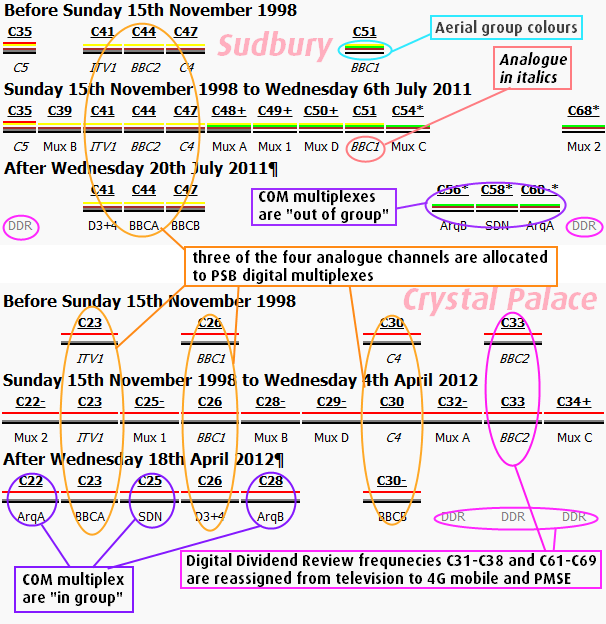Changes to the "Frequency Information" section of the transmitter pages
 Brian Butterworth published on UK Free TV
Brian Butterworth published on UK Free TV The changes have been made to make it easier to make comparisons between the various stages of transition between analogue-only and digital-only terrestrial.
The main change is that the channel allocations are now aligned above each other, and to allow for this format the name of the analogue channels are now abbreviated to BBC1, BBC2, ITV1, C4 and C5 and shown in italics.

In addition, channels that have been removed from television use after switchover are marked with DDR for "digital dividend review".
The aerial group colours are still shown for each allocated channel, "out of group" frequencies are still shown with an asterisk.
The new format makes it clear that, for most transmitters, three of the four "old analogue" frequencies are allocated to the PSB multiplexes after switchover (the other usually being a DDR).
4:02 PM
I realise it's a lot of work, but would it be possible to incorporate the interim stages for transmitters that can't go to final channels in one step?
I know that the information is available from Postcode Checker - Trade View (for example) but I find it more accessible in your format.
| link to this comment |
Briantist:
Excellent work.
One thing I have noticed is that
the 'Comparison of analogue and digital signal levels' is not to scale.
EG.
Analogue 1-4 = 35W
BBCA, D3+4, BBCB = 7W (-7dB)
So 7/35 = 5 (or 5 7 are 35)
but the top line is not 5 times longer but about 1/5 longer.
| link to this comment |
Mark's: mapM's Freeview map terrainM's terrain plot wavesM's frequency data M's Freeview Detailed Coverage
Should be 35/7 = 5
| link to this comment |
Mark's: mapM's Freeview map terrainM's terrain plot wavesM's frequency data M's Freeview Detailed Coverage
4:19 PM
Mark A.: Just like the broadcasters, we use decibels, because the signal strength reduces logarithmically with distance, not linearly.
One-fifth is actually not a very large drop in power - especially compared to the difference in signal-to-noise ratio required for PAL, which was 43 dB, and that for the post-DSO digital mode, about 20 dB. The other 16 dB is a margin to allow for the normal variation of levels - on analogue you'd see increased snow, annoying but not totally obscuring the picture, but digital would start cutting out.
Your box likely has a very wide range of gain available. Mine claims to handle 35 to 95 dBuV, a range of 60 dB or one million times the power. (1000 times the voltage, because power = voltage squared divided by resistance.)
At some sites, the pre-DSO digital power can be a tiny fraction of analogue power - e.g. Sutton Coldfield analogue is 125x more than low-power digital, or Sudbury analogue was 227x more powerful than Mux D. Using your method, the bar would be incredibly short, giving quite a false impression.
| link to this comment |